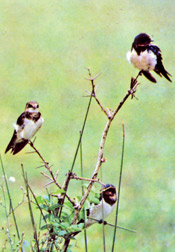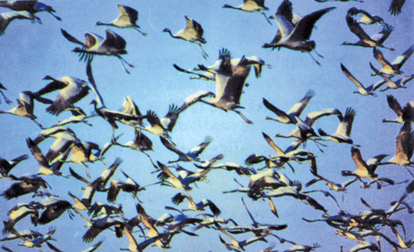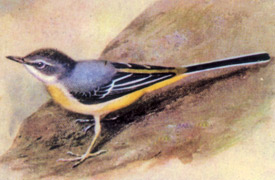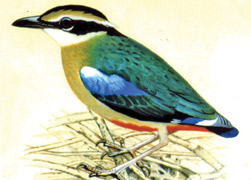Migrant birds homeward bound
by K. G. H. Munidasa
|

Blue-tailed Bee-Eater

Common Swallows |
|

Waterfowl on migration
|
Thousands of migrant birds, which had arrived in Sri Lanka during the
North-East Monsoon last year, have now left for their distant breeding
grounds. They generally commence their homeward journey late in March,
but the vast majority of them leave during April and early May, when the
South-West Monsoon is about to break, in September to October.
This year the Common Swallow appears to have left much earlier than
in the recent past. I was surprised to find none in evidence in the
Kelani Valley area by end of the third week of April, though one could
see thousands flying over at sunset, just ten days ago.
When the migration is on, birds are accustomed to flying even by
night, depending on the moon and constellation of stars to maintain
their course. It is probable that the Swallows too, decided to leave
whilst the moon was completing its last quarter, about the final week of
March.
Similarly, the Blue-tailed Bee-Eaters could have surely left our
shores earlier this year than in the last. However, observers in the
northern regions may still see scattered parties of them, as this
species is one of the last to cross over to the Indian mainland. Yet, on
the eve of the Sinhala and Hindu New Year vacation, I saw a few flying
over in a northerly direction around 5.30 p.m.

Grey Wagtail

Indian Pitta |
According to observers in the South and South-Eastern coastal areas,
the majority of the migrant waders and shore-birds had already left this
year by the third week or so last month.
The Brown Shrike is still here, nevertheless. A couple of days ago I
saw one fighting it-out with a pair of Red-vented Bulbuls, on the banks
of the Sitawaka river, as I cycled past the place. The following evening
I could hear the unmistakable note of a Brown Flycatcher in a tree in
the homegarden, at 5.30. But the next Himalayan visitor, Indian Pitta,
had left for its breeding grounds some time ago.
Two other migratory birds which normally stay with us until mid-April
are the Indian Blue-Chat and the Kashmir Red-breasted Flycatcher, met
only in the Central Mountain Zone.
One morning, in the third week of April, I was in my compound about
6.30 talking to a friend when I spotted a Blyth’s Reed-Warbler threading
its way in the tall grass at the edge of garden. This was yet another
East European migrant which had opted to stay with us a little longer
than usual. Perhaps, the last to leave are the wagtails. In their
customary roosting places in the dry zone jungles, the Forest Wagtails
are recorded as late as the second week of May. However, the Eastern
Grey Wagtail is found to leave for its breeding grounds, weeks earlier.
|

The Indian White Wagtail |
|

|
|

